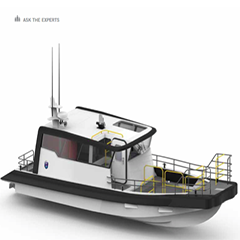Tuco Marine Group specialises in manufacturing ocean-going vessels that have light structures and hulls created with composite materials such as carbon fibre. Naturally, the wind industry is a prime market for the Denmark-based company and indeed, it has been going from strength to strength. We spoke to company founder, Jonas Pedersen.
PES: Welcome to PES. Would you like to introduce the company and tell us a little about how you serve the wind industry?
Jonas Pedersen: Our company was founded in 1998, which makes us 17 years old. We are boat builders, essentially. We have been working with turbine manufacturers from the early days and have worked with the three largest companies in the development of the blades before they were built. So we were in the business when the 34m was first built and a lot has happened since then. We have been in close dialogue with them ever since and build vessels that are uniquely placed to meet their needs.
So as I say, boat production is our main task, and our yard here has produced 276 boats – with our main focus today in the commercial ship business. Furthermore, we have been working for the Danish offshore companies for years, producing faster rescue boats and Fast Rescue Craft (FRC). We have been building boats like this for the military and it has developed into a growing market for offshore wind. In addition, we produce service accommodation vessels.
PES: What are the most common challenges you face when dealing with wind operators? How do you overcome those challenges?
JP: In general, the industry is looking for fast and cheap transfers. They are interested in moving staff over to offshore wind farms and what that boils down to is our craft. The use of these crafts is a lot faster than moving the mother ship to the windmill. The industry needs to have as big a weather window as possible, so we optimise that for them – safely and with comfort.
Of course, you are limited by size as far as the weather windows goes, so some of the things we have done is carry the cargo and then de-load with the crane against the boat landing.






























